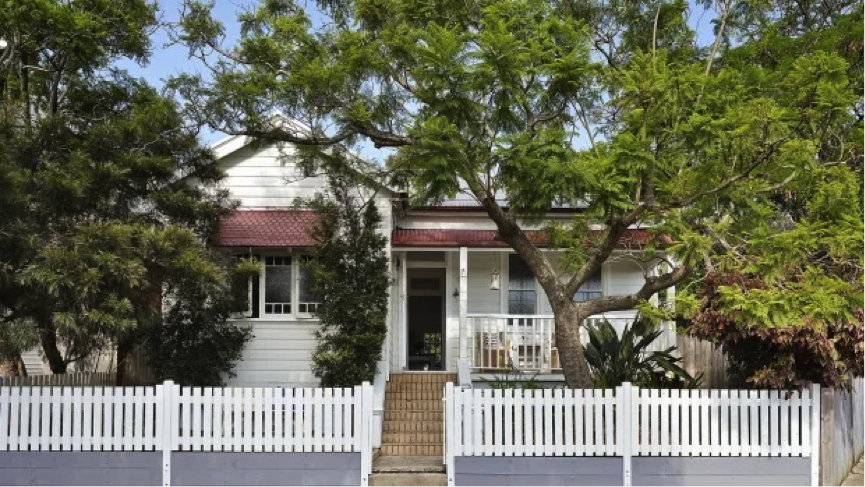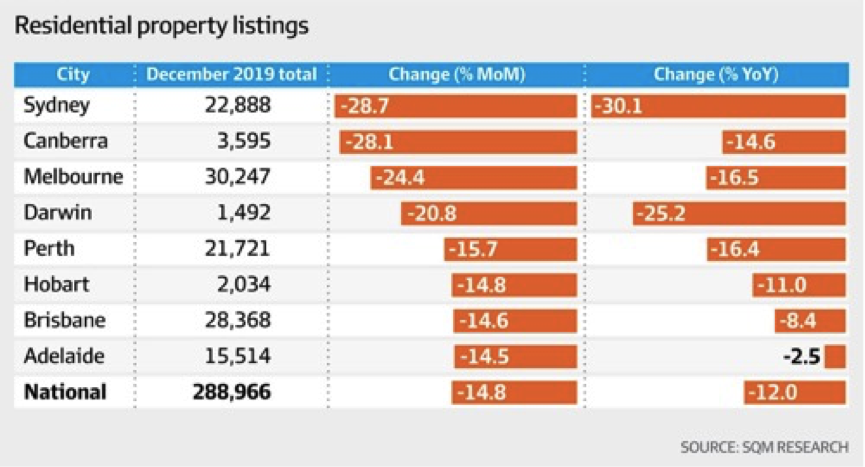Nila SweeneyReporter
Jan 7, 2020 – 2.24pm
Home listings fell sharply over the year to December as strong buyer demand absorbed any remaining November stock before the quiet summer period, indicating the market recovery is spreading outside Sydney and Melbourne.
The latest figures from SQM Research showed the number of homes listed for sale has plummeted 30.1 per cent in Sydney, while Melbourne tumbled 16.5 per cent.

Expectations for house price growth have returned. Supplied
Listings in Perth sank 16.4 per cent, Canberra 14.6 per cent and Brisbane 8.4 per cent.

Nationally, the stock level slumped 12 per cent compared to a year ago.All capital cities also recorded large declines in property listings during the month of December, with the steepest drop recorded in Sydney of 28.7 per cent, followed closely by Canberra of 28.1 per cent.
Nationally, listings fell 14.8 per cent over the same period.
Louis Christopher, managing director of SQM Research, said that while the monthly decline was normal for December due to seasonal factors, the year-on-year drop is unusual.
“December traditionally records falls in properties listed for sale as it is the start of the festive and summer holiday period, while November shows a surge in listings as vendors are keen to sell before the holiday season approaches,” he said.
“What is unusual, and a sign of a very strong market, is the year-on-year falls across all cities, particularly in older listings.”
Mr Christopher said a huge chunk of the November listings had already been absorbed as shown by the large drop in the older stock – homes that have been on the market for 30 to 60 days.
The months of November and December were great selling months.
— Louis Christopher, SQM Research managing director
In Sydney, older listings were down 69.53 per cent compared to the 30-day listings in November. In Melbourne, it was lower by 65.42 per cent, Brisbane by 33 per cent, Perth by 41.9 per cent and Canberra by 65.5 per cent.
“What this means is that most of the stock that hit in November, and we did record a big surge in listings activity in November, has been absorbed. It went very quickly, and that happened for nearly every city,” he said.
“This tells me straight away that across the capitals, the months of November and December were great selling months.
“Buyers were out in the market and vendors that came to the market in November managed to sell nearly everything. So we think that is a big sign of stronger activity in the marketplace.
“This suggests to me that the recovery is strengthening not just in Sydney and Melbourne but across a number of cities.”
Buyer interest surges
A realestate.com.au search data showed the growth in buyers searching continued to accelerate in many states, with Brisbane recording a 63 per cent jump in searches, NSW 50 per cent and Victoria 36 per cent over the year to December.
Mr Christopher said while the recent devastating bushfires in NSW, Canberra and Victoria could result in declines in property listings and affect values in these regions, it would not have a material impact on the city markets.
Looking ahead, he said listings were set to pick up in February as more vendors put their homes up for sale.
“February is likely to be a strong month for new listings. That’s when the market really opens up,” Mr Christopher said.
“We’ll likely start seeing a rise in listings after Australia Day. But remember, we’ve got a lot of old stock that is now being absorbed quickly, so overall, I’m still expecting the trend to decline.”
Asking price rises
The stock shortage is reflected in the solid rise in asking prices with the capital city average rising by 2.4 per cent for houses and 0.8 per cent for units during December.
Sydney has climbed back to its 2017-18 highs of more than $1.3 million after recording a 2.4 per cent increase over the same period.
The median asking house price in Sydney is now $1,341,400.
Overall, Melbourne recorded the strongest price growth of 4.2 per cent for houses but the unit market fell by 0.6 per cent.
Melbourne’s median house asking price has reached $1,027,600. The last time this occurred was between April and June 2018.
Compared to a year ago, the capital city asking prices rose 5.8 per cent for houses and 1 per cent for units.
“The strength of buyer demand is off the Richter scale, particularly in Sydney and Melbourne,” Mr Christopher said.
“I do believe that buyer demand is going to be strong throughout 2020. If we see another rate cut, that’s only going to accelerate demand even more.
“The property market doesn’t need another rate cut. Buyer demand is already very strong.”

